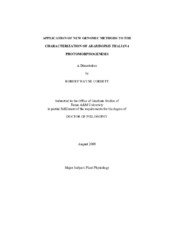| dc.description.abstract | The ability of plants to not only detect but also adjust to their environment is
crucial for their survival. The genes involved in photomorphogenesis – developmental
changes in response to light – and their regulation have long been of interest to
researchers. While the phytochrome and cryptochrome photoreceptors have been
isolated and partially characterized, the downstream components of the light signaling
pathway which transmit the perceived light signals and regulate gene expression are still
being discovered. A negative regulator of photomorphogenesis, DET1 (de-etiolated 1),
was discovered in a mutant screen for plants that develop a light grown phenotype in the
dark. DET1 is nuclear localized, but its exact function remains unknown. Two
contrasting mechanisms for the role of DET1 in the regulation of gene expression have
been proposed based on studies of the tomato and human orthologs of DET1. In order to
reveal the mechanism and molecular context of DET1 action, suppressor mutant screens
were employed to discover additional genes acting in conjunction with DET1
(designated as TED genes). In this research, new genomic methods were developed and employed to identify the genes underlying the ted1-1SD and ted2-1D suppressor
mutations.
A long hypocotyl QTL and suppression of the det1-1 dark grown phenotype by
the Bensheim (Be-0) ecotype of Arabidopsis mapped to the HAT4 gene, a homeoboxdomain
leucine-zipper transcription factor involved in shade-avoidance responses.
Sequence analysis uncovered two functionally distinct alleles of HAT4 in the Be-0
alleles of HAT4 compared to the genomic standard Columbia (Col-0) ecotype.
Expression analysis showed that in addition to negative autoregulation by itself, HAT4 is
also negatively regulated by DET1. The ted2-1D mutation was mapped to a 57 Kbp
interval on chromosome I containing three likely candidate genes. Suppression of the
det1-1 phenotype by ted2-1D is overdominant which is highly unusual and typically
associated with hybrid vigor or heterosis traits. The discovery of the genes underlying
the ted1-1SD and ted2-1D suppressor mutations have furthered the understanding of the
role for DET1 in regulation of photomorphogenesis as well as mechanisms involved in
overall gene regulation during light signaling. | en |


